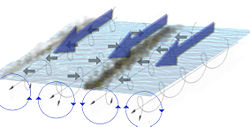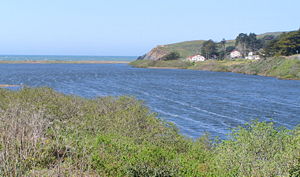
Langmuir circulation
Encyclopedia


Helix
A helix is a type of smooth space curve, i.e. a curve in three-dimensional space. It has the property that the tangent line at any point makes a constant angle with a fixed line called the axis. Examples of helixes are coil springs and the handrails of spiral staircases. A "filled-in" helix – for...
circulation in the ocean with the axis almost parallel to the wind. Irving Langmuir
Irving Langmuir
Irving Langmuir was an American chemist and physicist. His most noted publication was the famous 1919 article "The Arrangement of Electrons in Atoms and Molecules" in which, building on Gilbert N. Lewis's cubical atom theory and Walther Kossel's chemical bonding theory, he outlined his...
discovered this phenomenon after noticing windrow
Windrow
A windrow is a row of cut hay or small grain crop. It is allowed to dry before being baled, combined, or rolled. For hay, the windrow is often formed by a hay rake, which rakes hay that has been cut by a mower machine or by scythe into a row, or it may naturally form as the hay is mowed...
s of seaweed in the Sargasso Sea
Sargasso Sea
The Sargasso Sea is a region in the middle of the North Atlantic Ocean, surrounded by ocean currents. It is bounded on the west by the Gulf Stream; on the north, by the North Atlantic Current; on the east, by the Canary Current; and on the south, by the North Atlantic Equatorial Current. This...
in 1938.
The circulation was found to be 15° to the right of the wind in the northern hemisphere
Northern Hemisphere
The Northern Hemisphere is the half of a planet that is north of its equator—the word hemisphere literally means “half sphere”. It is also that half of the celestial sphere north of the celestial equator...
and the helix forming bands of divergence
Divergence
In vector calculus, divergence is a vector operator that measures the magnitude of a vector field's source or sink at a given point, in terms of a signed scalar. More technically, the divergence represents the volume density of the outward flux of a vector field from an infinitesimal volume around...
and convergence
Convergence zone
Convergence zone usually refers to a region in the atmosphere where two prevailing flows meet and interact, usually resulting in distinctive weather conditions....
at the surface. At the convergence zones floating seaweed, foam and debris will concentrate and form the bands Langmuir noticed in 1938. At the surface the circulation will set a current from the divergence zone to the convergence zone and the spacing between these zones are of the order 15–300 m. Below convergence zones narrow jets of downward flow form and the magnitude of the current will be comparable to the horizontal flow. The downward propagation will typically be in the order of meters or tenths of meters and will not penetrate the pycnocline
Pycnocline
A pycnocline is the cline or layer where the density gradient is greatest within a body of water. An ocean current is generated by the forces such as breaking waves, terms of temperature and salinity differences, wind, Coriolis effect, and tides caused by the gravitational pull of the Moon and the...
. The upwelling
Upwelling
Upwelling is an oceanographic phenomenon that involves wind-driven motion of dense, cooler, and usually nutrient-rich water towards the ocean surface, replacing the warmer, usually nutrient-depleted surface water. The increased availability in upwelling regions results in high levels of primary...
will generally be less intense and take place over a wider band under the divergence zone.
In an observation done at windspeeds of 14 m s−1 the horizontal spacing of the cells were 20 m and maximum vertical velocity was -18 cm s−1.

